Geoff Nicholson's Blog, page 34
October 17, 2018
WALKING MADLY
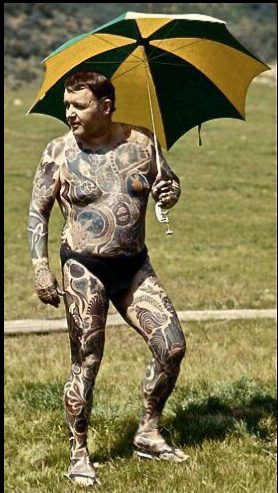
‘It was a warm afternoon in early September when I first met the Illustrated Man. Walking along an asphalt road, I was on the final leg of a two weeks’ walking tour of Wisconsin. Late in the afternoon I stopped, ate some pork, beans, and a doughnut, and was preparing to stretch out and read when the Illustrated Man walked over the hill and stood for a moment against the sky.”
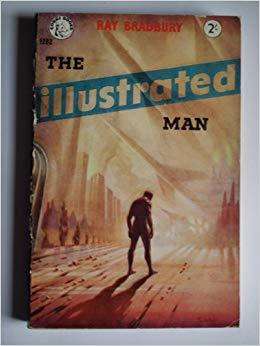
Those are the opening lines of Ray Bradbury’s The Illustrated Man, a collection of linked short stories posing as a novel. I can’t say I’d forgotten the lines because I’ve never actually read the book from beginning to end, though I have read at least one of the stories it contains – ‘The Veldt.’
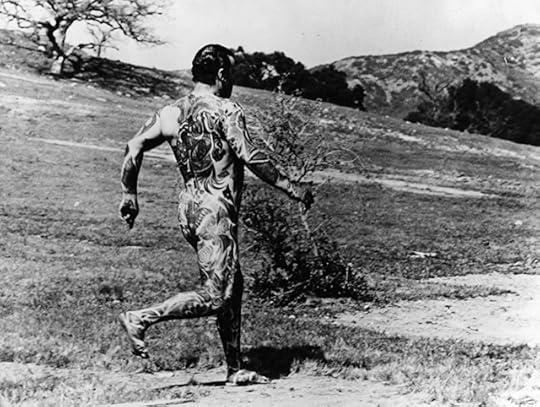
But I have seen the movie and I have never forgotten the sight of Rod Steiger, all naked and tatted up. The book describes him as “a walking treasure gallery.”
Gotta say I didn’t know that people went to Wisconsin on walking tours, but it seems they very definitely do. The state seems to be dense with walkers and walking trails.


When I first lived in Los Angeles, Ray Bradbury was alive and well and doing a lot of public appearances around town, many of them in Glendale. I don’t know how much of a walker he was but sometimes apparently he walked while wearing a suit, like this:
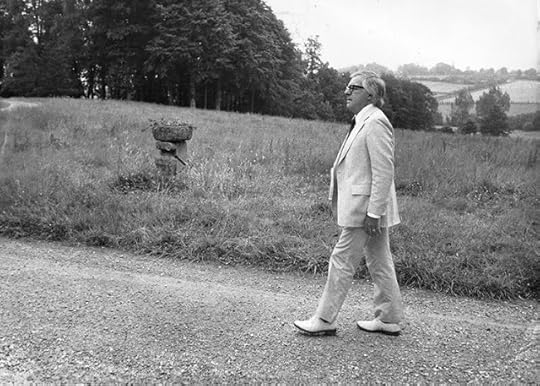
And I think he must have been rather proud of his legs, perhaps honed and toned by walking, because he was always showing them off in shorts; like this:
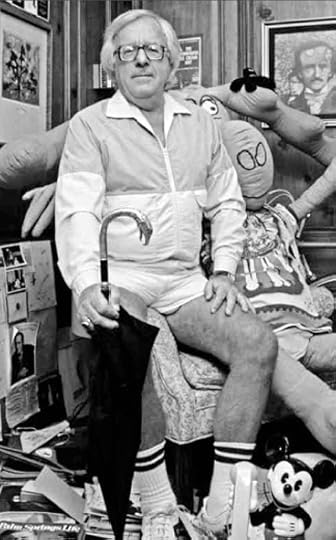
Tangentially I have been reading Museum Without Walls,some collected essays by another writer who also walks while wearing a suit, at least when the cameras are on him; Jonathan Meades, a man I can’t quite imagine in shorts.
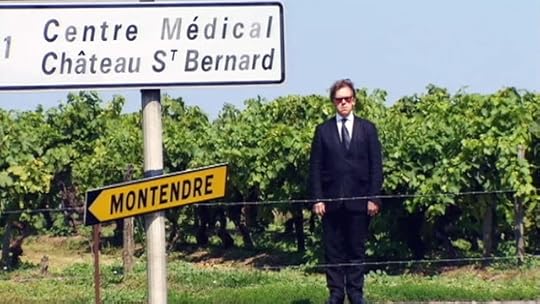
In a piece on Ian Nairn, Meades writes of “the ever-increasing battalions of soi-disant psychogeographers - who are distinguished from plain geographers by neglecting to take their Largactil before they release themselves into the edgelands of Sharpness or the boondocks of Sheppey.”
What oft was thought, but ne'er so well express'd.
Largactil, as some of you will know, and some may not, is one of the trade names for Chloropromazine, an anti-psychotic. Looks like good stuff:
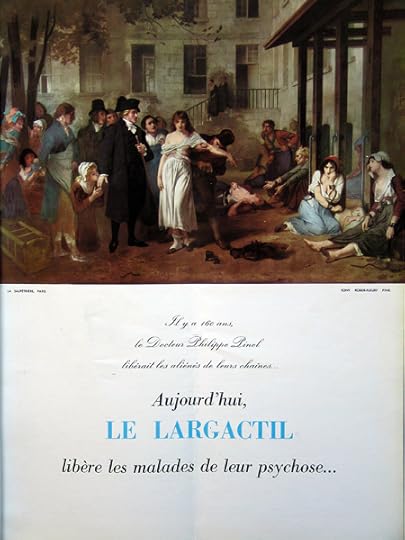

Published on October 17, 2018 04:11
October 13, 2018
NICHOLSON, DESTROYER OF CITIES
If you’re going to walk all the way around a city, it helps (in once sense) if that city is small. On the other hand, all the great cities are big, and all the great walks are long. So perhaps some miniaturization is what’s required.

This is a model of Chicago I saw last month, in the Chicago Architecture Center, in a Mies van de Rohe building on upper Wacker Drive.
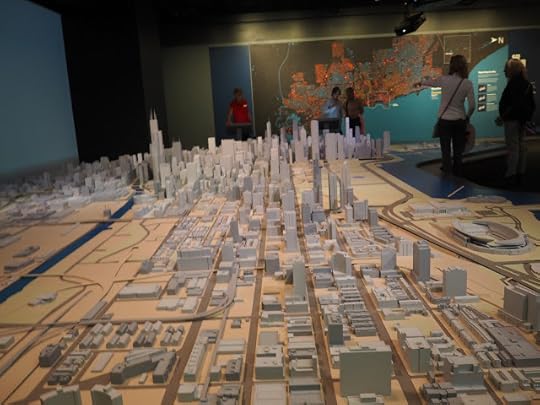
And this a model of London which is in the Building Center, in Store Street, “a bud for the built environment” since 1932.

The Chicago one even changes color:

I love miniaturization; model buildings, model railways, miniature golf courses. It makes me feel a bit like Gulliver and a bit like Godzilla. I know I could destroy large areas of the tiny city long before any security could get there. But I don’t do any destroying. I just walk around.
Here's a picture of Mies van Der Rose walking with Le Corbusier. Oh the laughs there must have been.
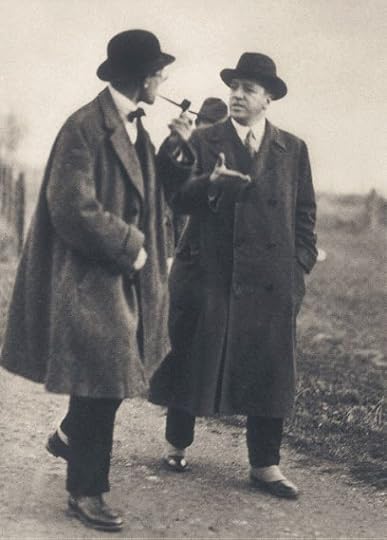
And here's another bloke who liked a bit of miniaturization:


Published on October 13, 2018 00:35
October 8, 2018
AMBIGUITY - HOW MANY TYPES YA GOT?
“I am living at the Villa Gorghese. There is not a crumb of dirt anywhere, nor a chair misplaced. We are all alone here and we are dead.”That’s Henry Miller, the opening lines of Tropic of Cancer, an author and a book I used to spend a lot of time thinking about. I don’t anymore but those lines have evidently stayed with me. This is a picture of Miller walking (more or less), I think in Brooklyn.
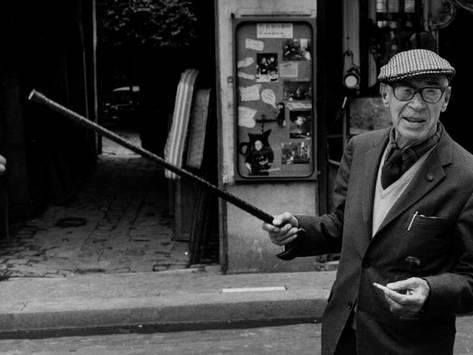
For my own part, I am living, or at least staying for a couple of weeks, in an Airbnb, in Endsleigh Court, in Bloomsbury.

The place is indeed very clean, and I can place the chairs wherever I want. I am certainly alone, but the feelings of wanting to be dead are becoming rarer. My therapist has views on this.
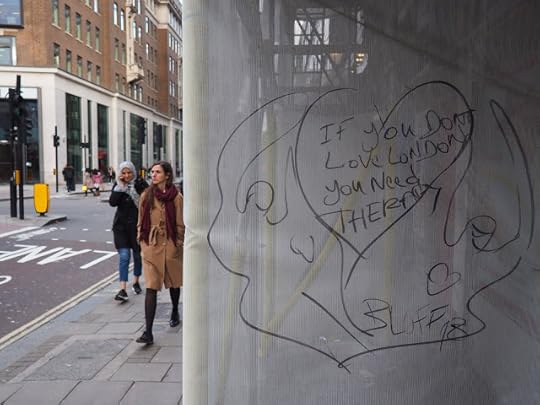
Some would say that everybody needs therapy.
One great thing about Endsleigh Court, since I’m on the 7thfloor, is that you can look out of the window, down into the street, and at certain times of day the walkers in Upper Woburn Place, are very beautifully lit (or backlit).

You know, in general I find that whole Bloomsbury Group franchise thing pretty insufferable. And I’m sure the feeling would have been mutual. If there were some shift in the space/time continuum and Virginia Woolf actually met me, I’m sure she’d have thought I was the kind of oik who should be taken down a dark Bloomsbury alley and given a good kicking. Hard to imagine which member of the Bloomsbury Group could have done that: maybe Vanessa Bell.

Still, you can’t object to a geographical area simply on the basis of who used to live there. Bloomsbury is a very decent area to walk around. It may lack the grit and grime of the most interesting areas of London but it’s full of curiosities, and you can’t have grit and grime all the time.
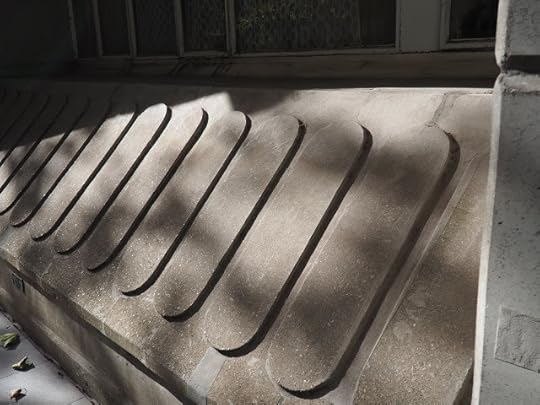
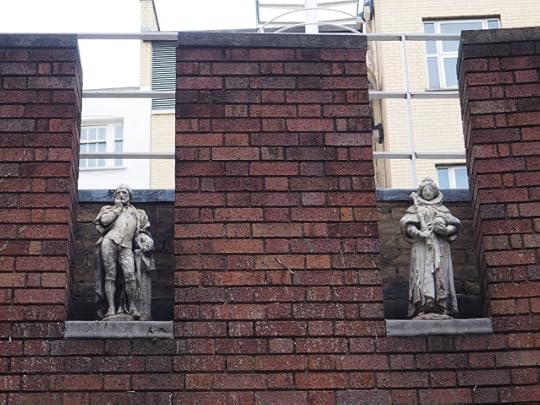
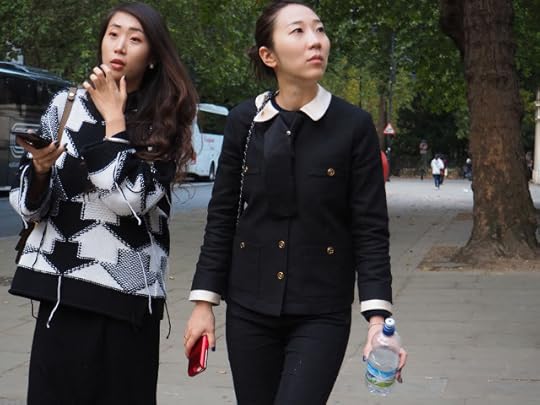
There are blue plaques everywhere, Dickens, Darwin, Dorothy L. Sayers, as well the whole Bloomsbury Bunch. But this one’s very special:
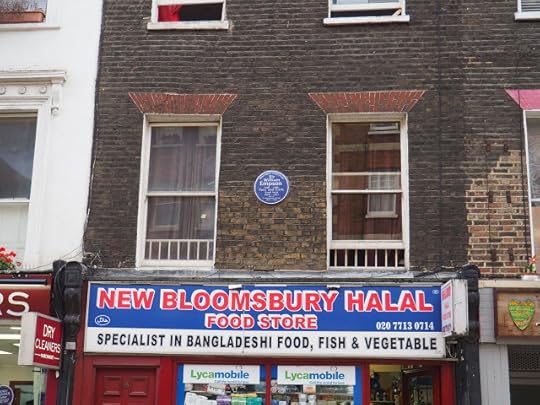
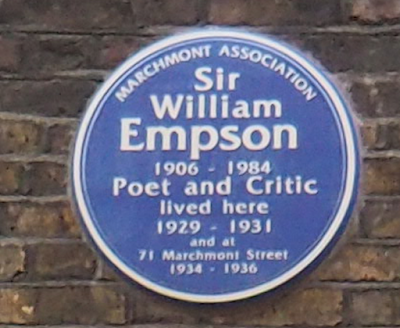
Empson was the author of Seven Types of Ambiguity, and given that he taught in Tokyo and Peking, he might have been enough of an orientalist to appreciate the Bangladesh connection. Empson was also, by adoption, another Sheffield lad, teaching at the university for the best part of 20 years – 1954 to 1972. He had a bunker-slash-man cave in the basement of 17 Wharncliffe Road. Sheffield has always been an essentially tolerant city but the idea that a man could walk its streets with a beard like Empson's and not have the dogs set on him, suggests that the city used to be even more tolerant than I imagined.
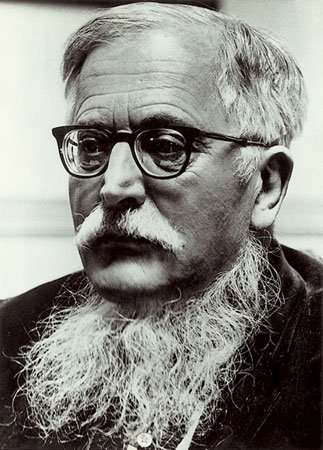
Anyway, back in Bloomsbury, my Airbnb is close to one of my favorite London buildings, the Mary Ward House:
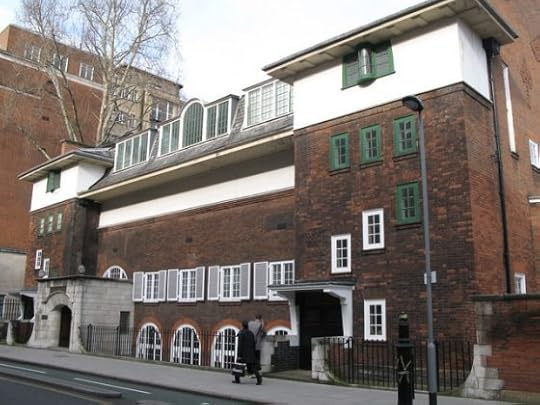
And I am suddenly reminded, though I never exactly forgot, of an odd and brief period in my life when I was dating a woman who was a doctor. She was very accomplished, and obviously smart, saving lives wherever she went, from Nottingham to Lesotho and back again. So she came down to London and we walked around and we were having a good enough time as far as I could tell, and we walked past the Mary Ward Centre and I said it was one of my favorite London buildings and she looked at me as though I was an idiot, and said something along the lines of “How can anybody have a favorite building?” She found it both absurd and incomprehensible that a person might walk around the built environment and have feelings about what he saw. I didn’t even try to explain. On that same day we walked down to the ICA where there was an exhibition that included Meret Oppenheim’s Object which I said I found really great.

My date, the doctor, did not. You can imagine how well this relationship went.
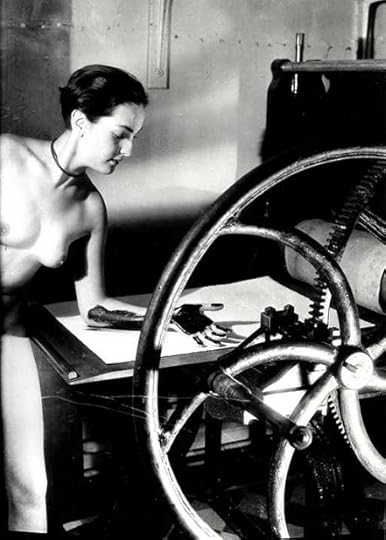 Meret in playful mood.
Meret in playful mood.
A last thought about William Empson, from Kenneth Lo, the chef, who was (apparently) Empson’s lodger when they both lived in Hampstead. Lo said that “William was one step removed from contemporary reality and seemed to stroll through life unhindered by its troublesome details.” Lucky old William, you might say.

For my own part, I am living, or at least staying for a couple of weeks, in an Airbnb, in Endsleigh Court, in Bloomsbury.

The place is indeed very clean, and I can place the chairs wherever I want. I am certainly alone, but the feelings of wanting to be dead are becoming rarer. My therapist has views on this.

Some would say that everybody needs therapy.
One great thing about Endsleigh Court, since I’m on the 7thfloor, is that you can look out of the window, down into the street, and at certain times of day the walkers in Upper Woburn Place, are very beautifully lit (or backlit).

You know, in general I find that whole Bloomsbury Group franchise thing pretty insufferable. And I’m sure the feeling would have been mutual. If there were some shift in the space/time continuum and Virginia Woolf actually met me, I’m sure she’d have thought I was the kind of oik who should be taken down a dark Bloomsbury alley and given a good kicking. Hard to imagine which member of the Bloomsbury Group could have done that: maybe Vanessa Bell.

Still, you can’t object to a geographical area simply on the basis of who used to live there. Bloomsbury is a very decent area to walk around. It may lack the grit and grime of the most interesting areas of London but it’s full of curiosities, and you can’t have grit and grime all the time.



There are blue plaques everywhere, Dickens, Darwin, Dorothy L. Sayers, as well the whole Bloomsbury Bunch. But this one’s very special:


Empson was the author of Seven Types of Ambiguity, and given that he taught in Tokyo and Peking, he might have been enough of an orientalist to appreciate the Bangladesh connection. Empson was also, by adoption, another Sheffield lad, teaching at the university for the best part of 20 years – 1954 to 1972. He had a bunker-slash-man cave in the basement of 17 Wharncliffe Road. Sheffield has always been an essentially tolerant city but the idea that a man could walk its streets with a beard like Empson's and not have the dogs set on him, suggests that the city used to be even more tolerant than I imagined.

Anyway, back in Bloomsbury, my Airbnb is close to one of my favorite London buildings, the Mary Ward House:

And I am suddenly reminded, though I never exactly forgot, of an odd and brief period in my life when I was dating a woman who was a doctor. She was very accomplished, and obviously smart, saving lives wherever she went, from Nottingham to Lesotho and back again. So she came down to London and we walked around and we were having a good enough time as far as I could tell, and we walked past the Mary Ward Centre and I said it was one of my favorite London buildings and she looked at me as though I was an idiot, and said something along the lines of “How can anybody have a favorite building?” She found it both absurd and incomprehensible that a person might walk around the built environment and have feelings about what he saw. I didn’t even try to explain. On that same day we walked down to the ICA where there was an exhibition that included Meret Oppenheim’s Object which I said I found really great.

My date, the doctor, did not. You can imagine how well this relationship went.
 Meret in playful mood.
Meret in playful mood.A last thought about William Empson, from Kenneth Lo, the chef, who was (apparently) Empson’s lodger when they both lived in Hampstead. Lo said that “William was one step removed from contemporary reality and seemed to stroll through life unhindered by its troublesome details.” Lucky old William, you might say.

Published on October 08, 2018 14:37
October 3, 2018
A MAN IMPROVED
Strange as it may seem, I was in Bradfield in the Peak District at the weekend. I was there for an event titled “Walking Through Time: A celebration of Sheffield’s Walking Heritage.” It was organized by my cousin Margaret and her husband Chris. I hadn’t seen either of them in a very long time, and I’ve never knew them all that well, but over the years they’ve become keen walkers it seems.
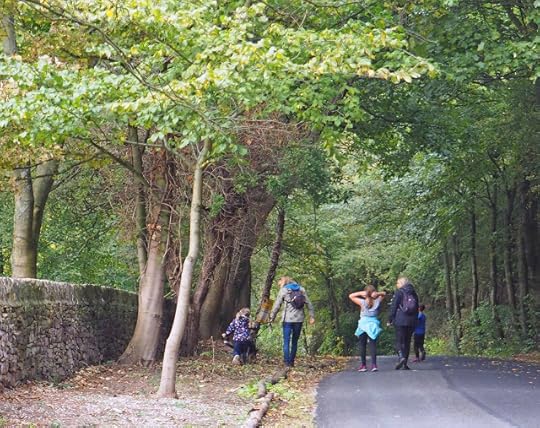
Bradfield, if the local literature is to be believed, “is probably the largest civil Parish in England covering 56 square miles, with over 100 miles of public footpaths,” and it has a boundary walk that’s pretty much 50 miles long.
There were talks in the village hall about the local wildlife, and rights for walkers including one by a former local MP on the Countryside and Rights of Way (CROW) Act, and there was music from a group called Clarion Call, singing songs about rambling. I was there to do my party piece about walking and trespassing with my dad.
The event didn’t in itself require any actual walking, so between acts I meandered from Low Bradfield to High Bradfield and back, which took me to St Nicholas’s Church which among other attractions has this very, very fine gargoyle:
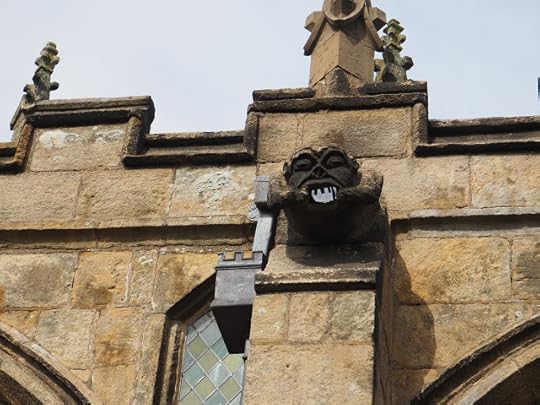
Back in the village hall there were people selling books, one fellow selling old photographs and postcards of the area, and another selling off the stock from the now defunct Sheffield Clarion Ramblers, including this lovely little volume (about two inches by three) which I bought, produced in the 1950s, still in amazingly good condition, with a fold out map at the back:
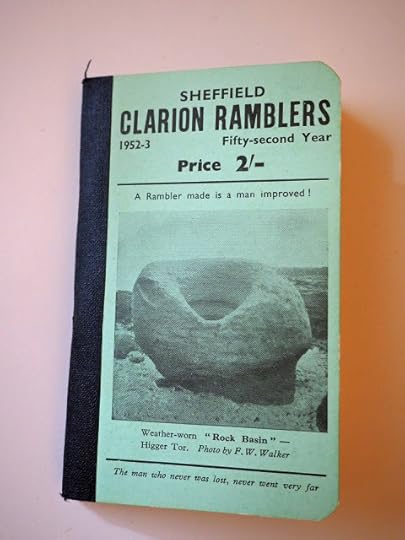
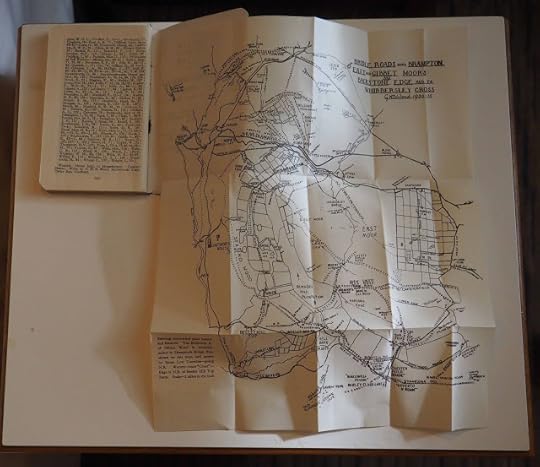
And best of all is that line on the front of the book, “The man who was never lost, never went very far,” attributed to GBH (Bert) Ward, who was a local steelworker and walking activist. It's a sentiment currently very popular with people who call themselves psychogeographers (and even Rebecca Solnit), but the date here is 1952/3 which is interestingly close to the year that Guy DeBord published his “Introduction to a Critique of Urban Geography” – 1955.And – (and now set your face to stun) – 1955 was also the year that Chet Baker released the album Chet Baker Sings and Plays containing the song “Let’s Get Lost.” And lord knows Baker was a man who, for a significant amount of time, lost himself quite spectacularly.
 “Ee by gum” as somebody probably said at some time in Bradfield. The "Walking Through Time" event raised 310 quid for the restoration of local stiles. I actually thought the local stiles were pretty wonderful as they were, but no doubt it would be better if there were more or them:
“Ee by gum” as somebody probably said at some time in Bradfield. The "Walking Through Time" event raised 310 quid for the restoration of local stiles. I actually thought the local stiles were pretty wonderful as they were, but no doubt it would be better if there were more or them:
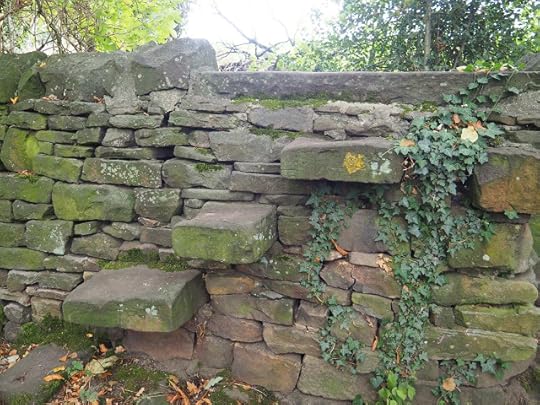
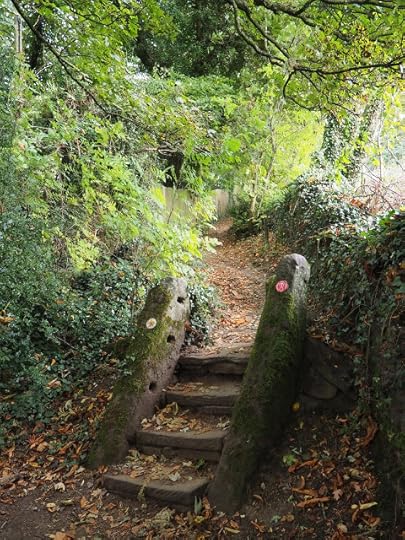


Bradfield, if the local literature is to be believed, “is probably the largest civil Parish in England covering 56 square miles, with over 100 miles of public footpaths,” and it has a boundary walk that’s pretty much 50 miles long.
There were talks in the village hall about the local wildlife, and rights for walkers including one by a former local MP on the Countryside and Rights of Way (CROW) Act, and there was music from a group called Clarion Call, singing songs about rambling. I was there to do my party piece about walking and trespassing with my dad.
The event didn’t in itself require any actual walking, so between acts I meandered from Low Bradfield to High Bradfield and back, which took me to St Nicholas’s Church which among other attractions has this very, very fine gargoyle:

Back in the village hall there were people selling books, one fellow selling old photographs and postcards of the area, and another selling off the stock from the now defunct Sheffield Clarion Ramblers, including this lovely little volume (about two inches by three) which I bought, produced in the 1950s, still in amazingly good condition, with a fold out map at the back:


And best of all is that line on the front of the book, “The man who was never lost, never went very far,” attributed to GBH (Bert) Ward, who was a local steelworker and walking activist. It's a sentiment currently very popular with people who call themselves psychogeographers (and even Rebecca Solnit), but the date here is 1952/3 which is interestingly close to the year that Guy DeBord published his “Introduction to a Critique of Urban Geography” – 1955.And – (and now set your face to stun) – 1955 was also the year that Chet Baker released the album Chet Baker Sings and Plays containing the song “Let’s Get Lost.” And lord knows Baker was a man who, for a significant amount of time, lost himself quite spectacularly.
 “Ee by gum” as somebody probably said at some time in Bradfield. The "Walking Through Time" event raised 310 quid for the restoration of local stiles. I actually thought the local stiles were pretty wonderful as they were, but no doubt it would be better if there were more or them:
“Ee by gum” as somebody probably said at some time in Bradfield. The "Walking Through Time" event raised 310 quid for the restoration of local stiles. I actually thought the local stiles were pretty wonderful as they were, but no doubt it would be better if there were more or them:


Published on October 03, 2018 11:23
September 25, 2018
PRAYER WALKS
After the best part of two days on the train to Chicago I decided to walk the mile or so from the station to the hotel – I was carrying very little luggage, as is my way.
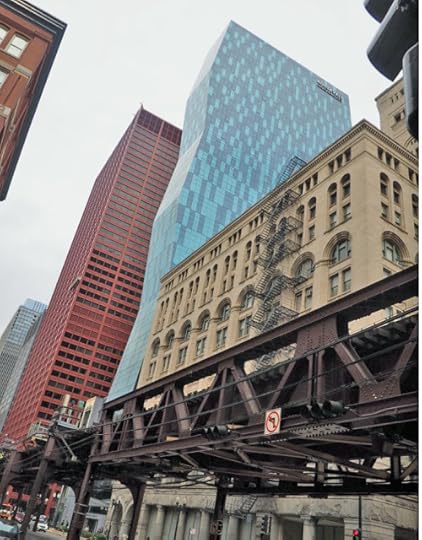
I was trying to get to Congress Avenue. The map made it look easy to find, which was just as well because I didn’t want to have to say to somebody, “Excuse me, I’m looking for Congress.”
As I walked I saw plenty of “street people” on the streets. In LA we’re used to seeing tents and improvised shelters on the sidewalks, and I couldn’t tell you if these guys hanging out were homeless or not. Some were certainly what we used to call panhandlers, but some of these guys seemed more interested in talking to each other that approaching passersby. But as I passed a small group of men at a corner one of then said very loudly, “Motherfucker!” I couldn’t tell whether he was addressing me or the universe in general. I chose to believe the latter, but I speeded up in any case.
That was not my best walking moment in Chicago, but this was, at the Art Chicago Institute there was this, an installation by James Webb titled Prayer:
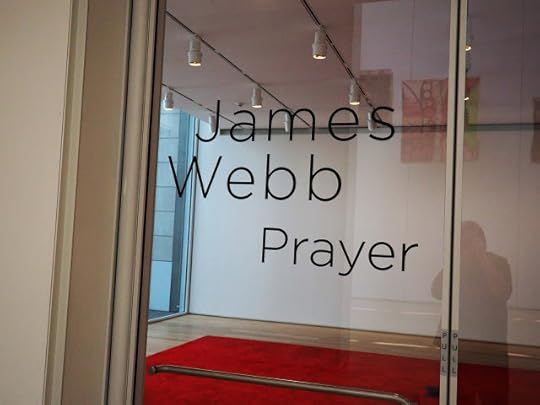
It involves a long broad stretch of carpet with loudspeakers embedded in it, and you experienced the work by taking your shoes off and walking among the speakers each of which is broadcasting a prayer from a different faiths. As you walk you can stop and concentrate on one message or listen simultaneously to two or to many of them in a cacophony.
Apparently some people kneel or even lie on the carpet, but I didn't see any of that, and for quite a bit of the time I was the only one in the time I was there I was the only there, at least until these gals arrived.
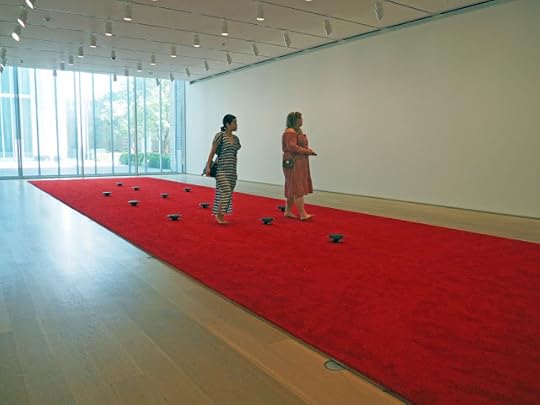


I was trying to get to Congress Avenue. The map made it look easy to find, which was just as well because I didn’t want to have to say to somebody, “Excuse me, I’m looking for Congress.”
As I walked I saw plenty of “street people” on the streets. In LA we’re used to seeing tents and improvised shelters on the sidewalks, and I couldn’t tell you if these guys hanging out were homeless or not. Some were certainly what we used to call panhandlers, but some of these guys seemed more interested in talking to each other that approaching passersby. But as I passed a small group of men at a corner one of then said very loudly, “Motherfucker!” I couldn’t tell whether he was addressing me or the universe in general. I chose to believe the latter, but I speeded up in any case.
That was not my best walking moment in Chicago, but this was, at the Art Chicago Institute there was this, an installation by James Webb titled Prayer:

It involves a long broad stretch of carpet with loudspeakers embedded in it, and you experienced the work by taking your shoes off and walking among the speakers each of which is broadcasting a prayer from a different faiths. As you walk you can stop and concentrate on one message or listen simultaneously to two or to many of them in a cacophony.
Apparently some people kneel or even lie on the carpet, but I didn't see any of that, and for quite a bit of the time I was the only one in the time I was there I was the only there, at least until these gals arrived.


Published on September 25, 2018 14:56
September 21, 2018
WALKING BY TRAIN
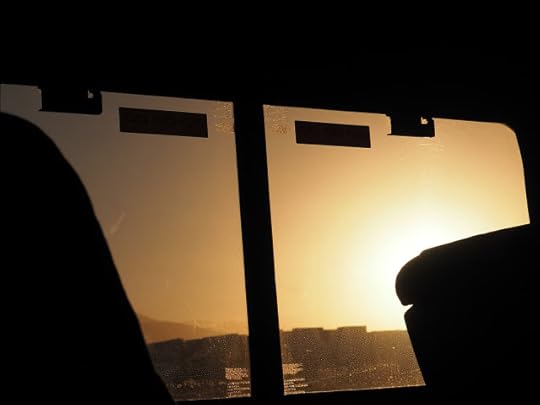
I went by train from LA to Chicago: it took 45 hours or so on the Southwestern Chief. I knew I’d do plenty of walking when I got to Chicago but on the train the walking opportunities are clearly limited.

You can walk to the toilet, to the observation car, to the cafe or the dining car but this isn’t real walking, obviously. And very occasionally you can look out the window and see somebody walking alongside the tracks or along the station platform, but that doesn’t seem very real either.
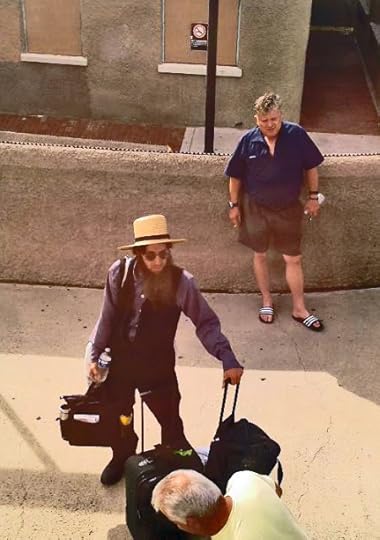
However there's lots of opportunity for reading, and I had a copy of the New York Review of Books with me, and in 45 hours you can read every single word of it, including the slightly sniffy review by Ian Jack of Iain Sinclair’s The Last London. I have only ever seen Ian Jack from a distance and frankly he didn’t look like much of a walker, which may explain something:

Even so, in the review he writes, “As a playful way of exploring and interpreting urban environments, psychogeography has a history in both England and France that goes back to the 1950s and the Situationism of Guy Debord, but it was Sinclair who resurrected it as a popular, or at least a fashionable, idea. Like ley lines (discovered or invented in 1921), psychogeography wasn’t designed to survive rational scrutiny …”

I think that’s pretty good, especially in a review that is essentially positive, and especially since it echoes my own prejudices about psychogeography and ley lines.

Published on September 21, 2018 21:28
September 8, 2018
WALKING WITH WELLS

My dad was in many ways an odd man. We did a lot of walking together, and we talked, though I think he did most of the talking. And one of his oddnesses was that he was absolutely sure he knew things even when he didn’t.
When I started reading “grown up” books he encouraged me read HG Wells’ The Time Machine and The Invisible Man, though I don’t know if he’d read them himself. And he also told me about The History of Mr Polly which he said was a book about a man who grew poisonous mushrooms in his cellar and killed his wife with them. This sounds like a perfectly reasonable premise for a book but it’s not what happens in The History of Mr. Polly, which I only read very recently.
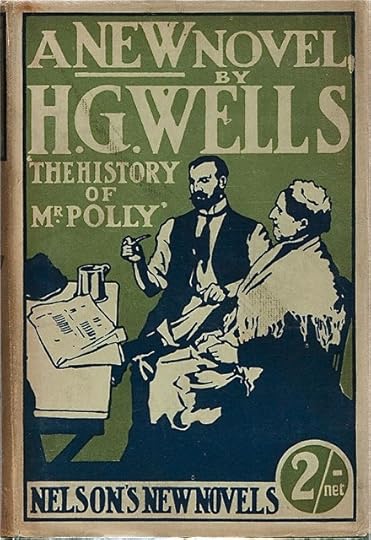
It's possible that he meant a short story by Wells, titled “The Purple Pileus,” about a hapless and unhappily-married shopkeeper named Coombes.
Mr. Coombes was sick of life. He walked away from his unhappy home, and, sick not only of his own existence, but of everybody else’s, turned aside down Gaswork Lane to avoid the town, and, crossing the wooden bridge that goes over the canal to Starling’s Cottages, was presently alone in the damp pinewoods and out of sight and sound of human inhabitation.
In the woods Coombes finds what he thinks are poisonous mushrooms, and eats them in an attempt to kill himself, but he doesn’t die. He’s transformed into a masterful and confident man, and his wife falls in love with him again. So again, not at all as described by dad.
So yes, I’ve been walking again and it does seem that here in Los Angeles we’re still in fungus/mushroom season. These, not especially lovely specimens, are in Culver City:

This is in East Hollywood, fungus thriving as it coexists with a traffic cone:

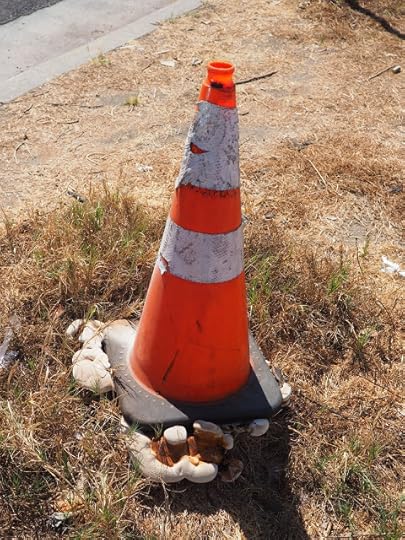
And when I got home, there was this waiting for me.

Fans of cacti may recognize that that the plant in the pot is a cardon, or “false saguaro,” but what, I hear you say, are those two pale yellowish nubbins down at the bottom of the pot? They are these things:

Arguably this is an indication that I’ve been overwatering my cardon. I've been trying not to, of course, but we know it happens. Anyway, the next day they looked like this:
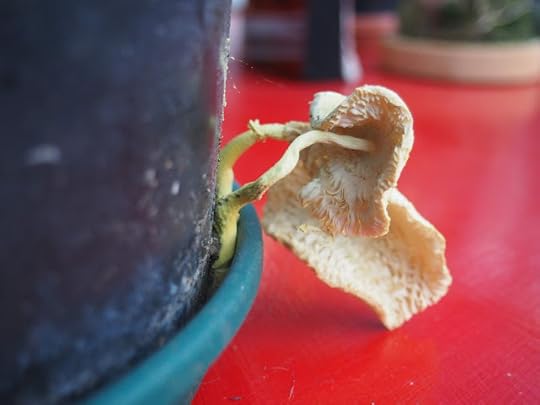
Using the online “Myokey fungus identifier” it seems they could be one of 150 or so different mushrooms including amanita. So then I did a reverse image search which suggested it might be this:

In fact that’s mochi ice cream, but even so I don’t want to risk eating it.

Published on September 08, 2018 14:39
September 5, 2018
HOLLYWOOD - PROIBITO OR MAGICA?
Sometimes Hollywood really gets up your backside.

Though the gal doesn't look like much of a walker.

Though the gal doesn't look like much of a walker.

Published on September 05, 2018 12:15
September 4, 2018
THE OBELISK WALK - DEUX
Look, obviously I don’t expect everybody to share all my obsessions, but since I got “hooked on obelisks” (title for a book?) I see them everywhere. Why only this morning this image of an obelisk by Athanasius Kircher popped up unbidden, and inscrutably, on my Facebook feed:
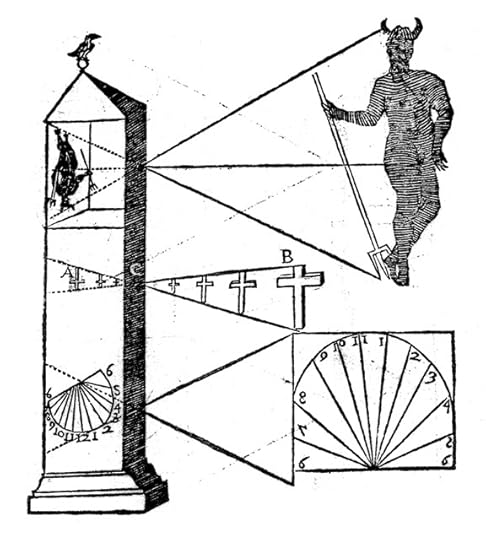
A little research reveals that it’s from Ars Magna Lucis et Umbrae, and it’s demonstrating the principle of the camera obscura, the devil being associated with shadows (I think).
Then I found this image by Edward Gorey (he was quite a man for an obelisk) – and as I’ve said before, everything’s better with skulls, even obelisks.
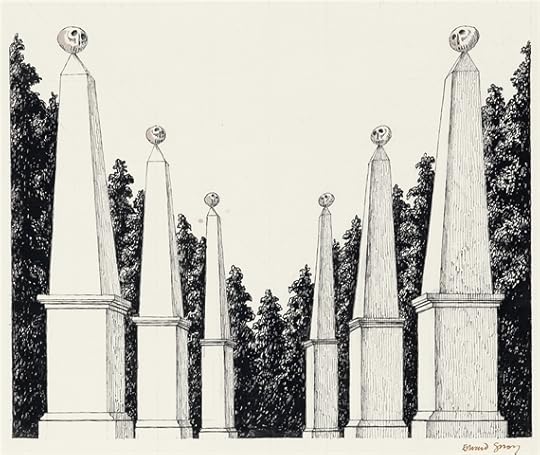
There are also two lines by Gorey in a poem titled "The Chinese Obelisks" that run as follows: A was an Author who went for a walk
B was a Bore who engaged him in talk.
And then last night I was walking past Amoeba Music, a shop that’s been in business in LA about as long as I have, with the consequence that the mural on the side that runs down Ivar Avenue, is looking a little faded these days.
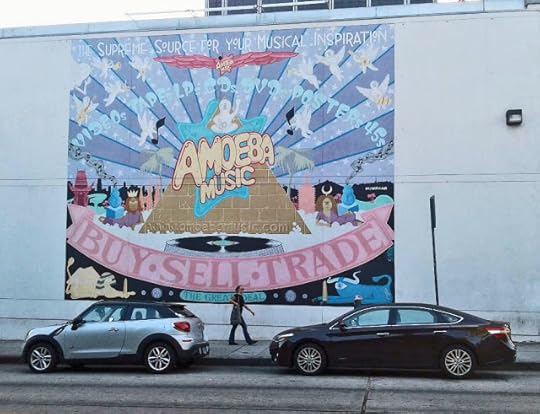
But then – holy smokes – I see that in the two bottom corners there are fantastical beasts and obelisks! Coincidence? Synchronicity? The universe sending me a message? You decide.
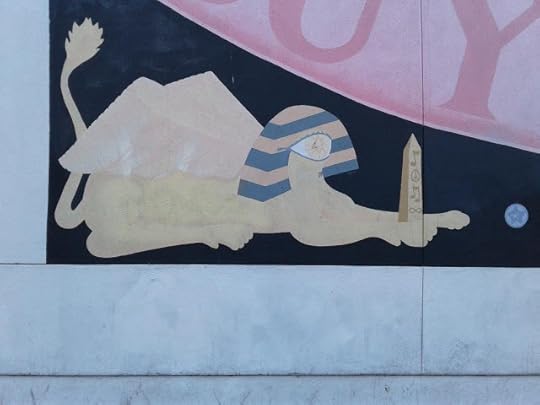
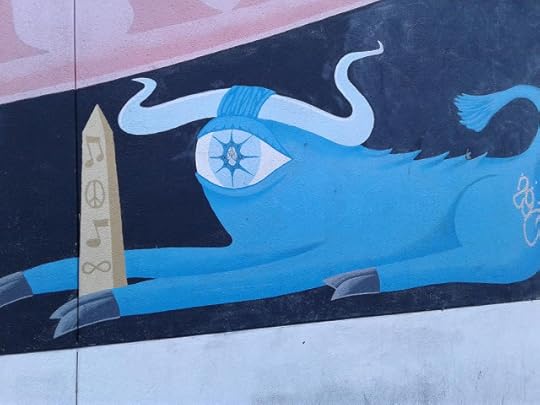


A little research reveals that it’s from Ars Magna Lucis et Umbrae, and it’s demonstrating the principle of the camera obscura, the devil being associated with shadows (I think).
Then I found this image by Edward Gorey (he was quite a man for an obelisk) – and as I’ve said before, everything’s better with skulls, even obelisks.

There are also two lines by Gorey in a poem titled "The Chinese Obelisks" that run as follows: A was an Author who went for a walk
B was a Bore who engaged him in talk.
And then last night I was walking past Amoeba Music, a shop that’s been in business in LA about as long as I have, with the consequence that the mural on the side that runs down Ivar Avenue, is looking a little faded these days.

But then – holy smokes – I see that in the two bottom corners there are fantastical beasts and obelisks! Coincidence? Synchronicity? The universe sending me a message? You decide.



Published on September 04, 2018 09:51
August 28, 2018
WALKING THE HIGHLANDS

Sometimes you do your research well in advance, plan your itinerary, and then you do your walking. Sometimes it’s the other way round – you go for a walk, see lots of stuff, and you get home and thendo the research, in arrears as it were.A little of both was involved in my recent drift through a very small part of Highland Park in northeast LA. I was part of a reading there at the weekend at a place called Bookshow – a bookshop-cum-tarot-reading salon (yes really). I had never been to Highland Park and it didn’t really register on my mental map of Los Angeles, which was one of the reasons I wanted to go there. Wikipedia said it is “currently inhabited by a variety of ethnic and socioeconomic groups,” which I suspected might be code for “hang on to your wallet, hipster.” But Time out said. “Figueroa Street has found itself as another source of increasing pedestrian activity, thanks to its Metro Gold Line stop,” which sounded better.

North Figueroa is the main drag through Highland Park, and Figueroa is one heck of a street running for some 20 miles, and from time to time (though not currently) it’s been part of Route 66. I guess I covered perhaps three of those miles in a meandering sort of way, to warm up for the reading. The area was, I think you’d have to say, “diverse.” On the one hand there were quite a few dodgy-looking places to cash checks and get loans, some garages where you wouldn’t feel all that happy about leaving your car, and the odd Botanica and Ferreteria.

Then there were hipster bars, record shops and places selling midcentury chairs and coffee tables at eye-watering prices.

And most spectacularly, there was Chicken Boy, who I’d heard about over the years but never seen, and I knew there was quite a backstory.
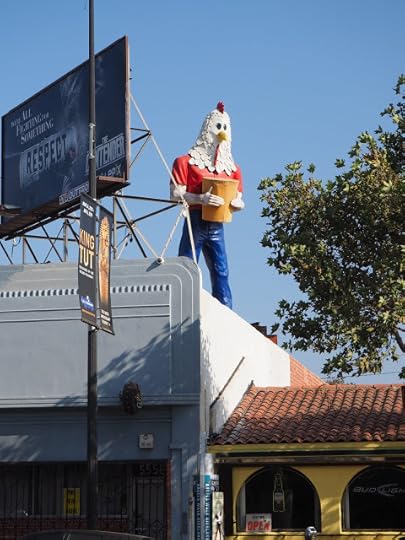
Chicken Boy – a human with a chicken head. customized from a fiberglass model of Paul Bunyon - first appeared in the 1960s on top of a fried chicken restaurant in downtown Los Angeles. The restaurant owner died and the model was taken down, and it was acquired by Amy Inouye – a book designer and art director. It went into storage for twenty odd years, eventually being resurrected on the roof of Inouye’s “Future Studio,” where for planning purposes it’s considered an "art installation," apparently.

It was impressive, but so were the two lions on top of Devon Glass and Mirror. It’s hard find the angle that gets both lions in the picture.

Research shows that they get painted in different colors from time to time. It also shows that Devon Glass and Mirror receives some poisonous online customer reviews.
One of the minor things to notice (and these might form part of Nicholson’s ongoing “guide to the ground”) are the mosaics in the sidewalk:
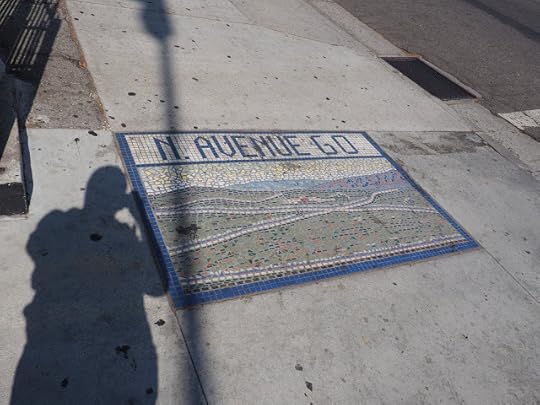
That actually says N. Avenue 60, not N. Avenue Go, which is how I first read it. There are 14 mosaics along this stretch of Figueroa, and I thought they looked suitably patinaed and historic but I was wrong about that. They were installed just this year, designed by Wick Alexander, and funded by a $149,000 grant from the Los Angeles City Department of Transportation. They were a long time coming since there were delays with permits and then the tiles had to be tested to ensure they were waterproof and non-slip. But they got there in the end.
Other things that caught my eye - Frida was there (she gets everywhere):
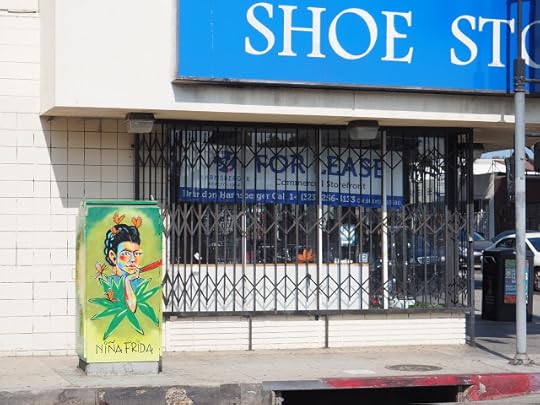
There were cacti for sale (always a plus in any neighborhood):

And there was this concrete tree by the station:

Yes, yes, I know this is all madly superficial. I shall go back to Highland Park, I swear, and get involved in some deep topography, the way you do.

Published on August 28, 2018 13:48
Geoff Nicholson's Blog
- Geoff Nicholson's profile
- 55 followers
Geoff Nicholson isn't a Goodreads Author
(yet),
but they
do have a blog,
so here are some recent posts imported from
their feed.



